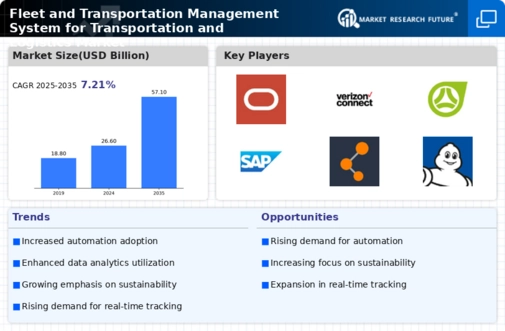E-commerce Growth
The surge in e-commerce activities is a significant driver for the Global Fleet and Transportation Management System for Transportation and Logistics Market Industry. As online shopping continues to expand, logistics providers are compelled to enhance their delivery capabilities. This shift necessitates the adoption of advanced fleet management systems that can efficiently handle increased order volumes and optimize last-mile delivery. The market's growth trajectory is closely tied to this trend, with projections suggesting that the industry will reach 57.1 USD Billion by 2035, as logistics companies adapt to the evolving demands of e-commerce.
Regulatory Compliance
The Global Fleet and Transportation Management System for Transportation and Logistics Market Industry is influenced by stringent regulatory requirements aimed at improving safety and environmental standards. Governments worldwide are enforcing regulations that mandate the use of advanced fleet management systems to monitor emissions and ensure compliance with safety protocols. For example, the European Union has set ambitious targets for reducing carbon emissions from transportation. As companies strive to meet these regulations, the demand for comprehensive fleet management solutions is likely to increase, contributing to a compound annual growth rate of 7.21 percent from 2025 to 2035.
Market Growth Projections
The Global Fleet and Transportation Management System for Transportation and Logistics Market Industry is poised for substantial growth, with projections indicating a market value of 26.6 USD Billion in 2024 and an anticipated increase to 57.1 USD Billion by 2035. This growth trajectory reflects a compound annual growth rate of 7.21 percent from 2025 to 2035, driven by factors such as technological advancements, rising demand for efficiency, and regulatory compliance. The market's expansion is indicative of the increasing reliance on sophisticated fleet management solutions to navigate the complexities of modern logistics.
Sustainability Initiatives
Sustainability initiatives are increasingly shaping the Global Fleet and Transportation Management System for Transportation and Logistics Market Industry. Companies are prioritizing eco-friendly practices, leading to the adoption of electric and hybrid vehicles within their fleets. This transition not only aligns with corporate social responsibility goals but also reduces operational costs associated with fuel consumption. As organizations commit to sustainability, the demand for fleet management systems that support these initiatives is likely to rise. This trend is expected to contribute to the market's growth, with a projected value of 26.6 USD Billion in 2024.
Technological Advancements
The Global Fleet and Transportation Management System for Transportation and Logistics Market Industry is experiencing rapid technological advancements, particularly in areas such as artificial intelligence, IoT, and big data analytics. These innovations enhance route optimization, predictive maintenance, and real-time tracking, thereby improving operational efficiency. For instance, companies leveraging AI-driven analytics can reduce fuel consumption by up to 15 percent. As organizations increasingly adopt these technologies, the market is projected to reach 26.6 USD Billion in 2024, reflecting a growing reliance on sophisticated systems to streamline logistics operations.
Rising Demand for Efficiency
In the Global Fleet and Transportation Management System for Transportation and Logistics Market Industry, there is a pronounced demand for operational efficiency. Businesses are under pressure to minimize costs while maximizing service quality. This trend is evident as companies implement fleet management solutions that provide insights into vehicle performance and driver behavior. Such systems can lead to a reduction in operational costs by approximately 20 percent. As efficiency becomes paramount, the market is expected to grow significantly, with projections indicating a value of 57.1 USD Billion by 2035, driven by the need for enhanced productivity.
















